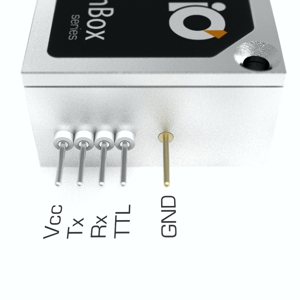
TTL stands for transistor-transistor-logic. In the context of laser modules, TTL modulation means a convenient and standardized method for switching CW lasers on and off at a high frequency. The voltage tolerance for TTL inputs of all MatchBox lasers is +5VDC. The modulation frequency is typically from tens of kHz to tens of MHz, depending on the laser model.
Fast TTL input can also be used for PWM control of laser output power.
Control Interface
MatchBox series lasers feature a Universal Asynchronous Receiver/Transmitter (UART) controller interface. The pinout is explained below - separately for diode and DPSS lasers.
Diode Laser with a regular spectrum

- Tx and Rx pins are used for communication, error read-out and change of parameters
- GND pin is common to the enclosure
- Vcc pin is used for +VDC power
- TTL pin can have two purposes: TTL ON/OFF modulation of the laser (in case of regular diodes) or control of a variable speed fan*** (in case of wavelength-stabilized diodes)
***TTL or FAN setting is factory pre-configured.
DPSS / narrow spectrum diode / high power diode lasers

- Tx and Rx pins are used for communication, error read-out and change of parameters
- GND pin is common to the enclosure
- Vcc pin is used for +VDC power
- FAN ctrl. pin is used for variable speed control of a fan***
***Can be configured into virtual TTL modulation having up to 1 kHz modulation bandwidth.
TTL pin in our lasers is configurable programmatically. Programmatically, the TTL pin can be used for modulation, fan control, and for additional interlock functions like ON/OFF laser control. However, setting TTL pin programmatically to have more than one purpose affects the speed of modulation - instead of modulation speed in MHz, it would be only a few kHz. For different types of MatchBox® lasers, there are different types of possibilities to use the TTL pin.
CW diode lasers:
- Non-SLM lasers: TTL pin is configurable only through hardware and its modulation speed can reach up to 10MHz in ACC operation mode and it can reach up to 1kHz in APC mode.
- SLM lasers: by default TTL pin is set to be used for fan control. no other parameters can be changed for SLM lasers.
- DPSS lasers: by default TTL pin is set to be used for FAN control. However, the TTL pin can be configurable for TTL modulation, but the speed of modulation is rather low - it can only reach up to 500Hz.
Laser Combiners:
Lasser combiners are similar to CW diode non-SLM lasers. TTL pin is configurable only through hardware. Modulation for all wavelengths inside the laser can be controlled independently and its' speed can reach up to 10MHz in ACC operation mode and up to 1kHz in APC mode.
Pulsed lasers:
Pulsed lasers allow TTL modulation at the speed of up to 1kHz. However, for pulsed lasers, TTL modulation means, that it is possible to shoot multiple rows of pulses with the envelope of 1kHz.
TTL Pin Configuration

Go to the main screen of our software --> Click 'more...' at the top right corner of the main software window --> Click on the 'Programmable Pin' icon.
P0: Pin as input to allow modulation with the proper hardware. It does not work with SLM lasers and DPSS.
P1: Pin as PWM output to control fan speed and stabilize laser body temperature
P3: Pin generates a preset signal. Modulates laser if laser supports modulation. This command is used for interlock.
Summary Table
| Setting |
CW lasers |
Pulsed lasers |
Combiner lasers | ||
| Non-SLM |
SLM |
DPSS |
|||
| P0 |
Yes |
NA |
NA |
Yes |
Yes |
| P1 |
Yes |
Yes |
Yes |
Yes |
Yes |
| P3 |
Yes |
NA |
NA |
Yes |
Yes |
| P4 |
NA |
NA |
Yes |
NA |
NA |